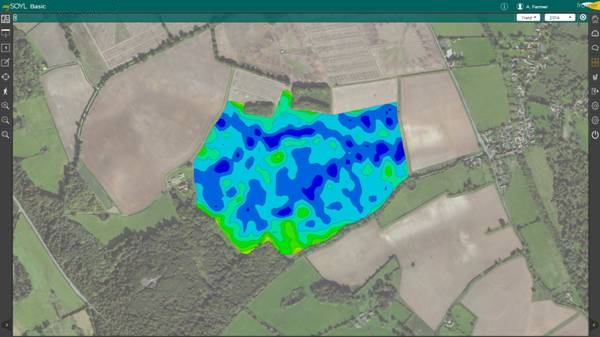SOYL newsletter August 2017
1. Winter Workshops 2018 
Continuing our informative training events throughout 2017, we will be running another series of our popular Winter Workshops during late 2017 and early 2018.
The SOYL team takes to the road in November. With many new and improved products and services launched this year and more in development, growers can find out how SOYL’s precision crop production services can add value to their business and Make Every Hectare Count.
As well as presentations and demonstrations from SOYL’s expert team, there will be plenty of opportunities to ask questions and speak directly to advisors.
Event details will be announced in the next few weeks. Places will be limited so keep an eye on our events page, the Making Every Hectare Count Blog and follow @SOYLprecision on Twitter.
2. Post harvest yield map tips 
Another year of combining is near complete and the yield data you’ve gathered holds great value if you know how to use it. This hasn’t been so easy in the past, but making practical sense of the data is now much easier thanks to MySOYL’s yield map hosting and performance mapping feature.
By putting together several years of data it’s now possible to identify where good areas of your fields may consistently yield, either by comparing a given crop type, a set period of years or a whole rotation. A yield map can be likened to a school report – the tonnage you grow overall is your grade but the report text highlights areas of good performance and also areas where you could have done better.
Gathering information on where your crops do better or worse across a field might tell you what you already know, but if there is a repeating trend you may be able to take action either agronomically or mechanically, especially as GPS data records location to trace where there is an issue. Combining yield map data with other measured factors such as nutrients, soil type or topography can show up potential causes or solutions to where yield consistently trends. SOYL’s performance mapping service will help to show this.
It’s never too late to start gathering information like yield data, even if you don’t make full use of it right away. More data means a bigger pool of information, but even one year’s worth may give some insights in the short term. A single year of yield data may not give all the answers as to how particular weather patterns might have affected yield, but some data is better than none. One variety of wheat may have done better on droughty land while another may have liked high pH soils, and seeing this trend on a yield map can help with cropping decisions for the following year.
Top tips for using yield mapping information
1. Don’t discard seemingly bad data as it can be calibrated based on what you actually sold off the farm and will highlight areas to look at.
2. Accept that there will be variation in the field and that this may be caused by a variety of factors.
3. Layer yield data with nutrient levels, seed rates, soil type and weed and disease pressure to ascertain seasonal trends.
4. Use MySOYL to store data and make use of it at a later date.
5. Consult with your SOYL area manager on how to maximise the use of your yield maps and field data.
3. Getting your rotational PK requirements right 
Each farm will likely have a different rotation from that of its neighbour and often even within farms there can be varying rotations based on crops grown, ownership and history. Managing a single rotation is hard enough, but then add in the P and K requirements of different crops, organic manures and across different blocks and this becomes more challenging.
Your SOYL area manager can help you to plan each rotation, making the most of each nutrient or product by using our rotational calculator to ensure each crop in the cycle is receiving the right amount based on off-take and the field’s soil indices. With crops such as maize and wholecrop cereals coming into more rotations, it’s vital to make sure you don’t underestimate what each takes off within the cycle. Forage maize, for example, can remove vast amounts of potash from the soil in its short growing period, as shown below.
Maize crop removal of P and K
| Yield of crop |
Phosphate (P2O5) |
Potash (K2O) |
| 40t/ha |
56 kg/ha |
176 kg/ha |
| 50t/ha |
70 kg/ha |
220 kg/ha |
| 60t/ha |
84 kg/ha |
264 kg/ha |
Don’t forget that potatoes may receive decent doses of fertiliser in the growing year but they also remove large amounts of nutrients when harvested. Potatoes are weighty potash users when growing and can also remove around 6kg/t of K2O, or nearly 300kg/ha for a 50 tonne/ha crop. Balancing these off-take amounts is vital to make sure that index deficiencies across a field are met using a solid variable rate programme for the arable rotation with perhaps a flat rate application for the potato crop to cover that particular need.
If you would like to discuss your P and K rotational requirements, please call the SOYL office on 01635 204190, or speak to your SOYL or Frontier contact.
4. This month on the SOYL blog
On the Making Every Hectare Count blog this month, we’ve shared details of the latest MySOYL upgrade, explained the importance of yield maps and nutrient maps and how to use them, and reflected on more than twenty years of working with KRM and Bogballe.
Don’t miss out on future posts – subscribe to the blog and receive email notifications of new content here.
Don’t forget to follow us on Twitter @SOYLprecision for regular updates on soils, nutrients, machinery and GPS.
To subscribe to future issues of SOYL news please click here.










